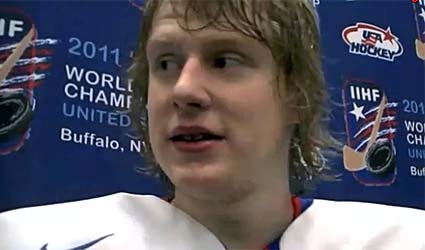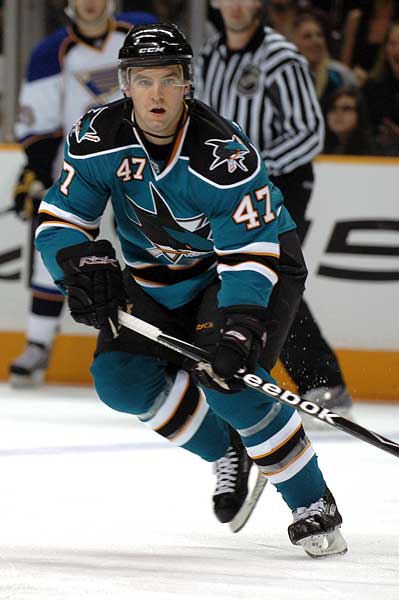Sobering offseason for San Jose Sharks organization tests a tight-knit hockey community

SHARKS 2011 DRAFT PICK DANIIL SOBCHENKO DIED IN SEPTEMBER LOKOMOTIV YAROSLAVL PLANE CRASH

FORMER SAN JOSE/WORCESTER SHARK TOM CAVANAGH PASSED AWAY IN JANUARY
It has been an offseason full of tragedy for the game of hockey. The San Jose Sharks organization was not spared. The deaths of three current and former NHL players who embraced the physical side of the game stunned the league, players and fans. Popular Minnesota Wild forward Derek Boogaard, a 6-foot-7 enforcer many considered the heavyweight champion of the league, died due to an accidental overdose in May. In August, Rick Rypien and former Maple Leaf/Predator Wade Belak may have taken their own lives under differing circumstances. Added to the unspeakable toll was the January death of well liked 28-year old Worcester Sharks forward Tom Cavanagh, whose long struggle with mental illness was not widely known. His death was also believed to be a suicide.
Several of Cavanagh’s teammates in Worcester and San Jose were unaware of his medical problems. After playing 4 years at Harvard, 4 years for the Sharks AHL affiliates in Cleveland and Worcester (Cavanagh is still the Worcester Sharks franchise leader in assists and points), and 18 games over two seasons in San Jose (where he briefly played on a line with Joe Thornton and Jeremy Roenick), his father Joseph Cavanagh told the Providence Journal-Bulletin that Tom’s “private struggle far surpassed his public athletic accomplishments.” In the stoic business of the National Hockey League, a young player known for his intelligence and work ethic tried to overcome his problems on his own. It is a theme that may carry over with the deaths of Boogaard, Rypien and Belak. The league needs to get to a place where it not only encourages players to ask for help, but convinces them that asking for help is not a weakness.
It is not clear how much, or if, it was a contributing factor in any of the deaths, but the debilitating effect of lingering head injuries and post-concussion symptoms was a problem the league was forced to address. After Sidney Crosby was knocked out for the season with back-to-back hits to the head by David Steckel and Victor Hedman in successive games, and Marc Savard was knocked out of Boston’s Stanley Cup Championship season with his second concussion in 10 months, the NHL and NHLPA took action in-season to introduce new concussion protocols. It required players who sustained head injuries to be removed from the ice and evaluated by medical personel. The protocols may be adjusted slightly this season, but the goal is to reduce damage that may impact players for a lifetime. The CBC ran a series of features on the issue of concussions and the NHL: evaluating a new helmet microchip that can offer an objective statistical model for hits to the head, detailed Patrice Bergeron and Willie Mitchell’s long road back from concussion injuries, and noted that advanced concussion testing has begun for many youth hockey players. Sidney Crosby was cleared for non-contract drills at the start of the Pittsburgh Penguins training camp. Logan Couture and defenseman Brent Burns are a pair of cornerstone players in the Sharks organization that have overcome concussion problems in the past.
There is no set schedule to mourn, but returning to one of the most difficult sports in the world is a measure of respect on it’s own. The turn of skates on fresh ice at training camp is another step in the healing process. That process was dealt a significant blow on September 7th. As the Kontinental Hockey League opened it’s 2011-12 hockey season (it’s fourth with teams in Russia, Kazakhstan, Belarus, Latvia and for the first time, Slovakia), a Yak-42 plane crashed on takeoff killing nearly the entire Lokomotiv Yaroslavl team and staff. 43 passangers and crew died immediately, and left wing Alexander Galimov died several days later due to extensive burns. It was one of the worst tragedies in hockey’s over 100 year history.
“This is the darkest day in the history of our sport,” IIHF President Rene Fasel said of the crash. In a statement released by the team, San Jose EVP/GM Doug Wilson noted that 2011 6th round Sharks draft pick Daniil Sobchenko was amonth those on the plane. “Daniil attended our development camp this past July and everyone on our staff agreed that he had a bright future with our organization,” Wilson said. “He was an amazing person with a fun-loving personality and his attitude and energy during his time in San Jose was infectious. Our deepest sympathies go out to his family and friends.”
The 3-time Russian champion Lokomotiv (1997, 2002, 2003) was a strong KHL side, winning it’s division and finishing 3rd overall in the 2010-11 season. They lost in Conference Finals to Atlant Moscow. As Atlant Moscow and Salavat Yulaev met in the season opener for a Gagarin Cup Final rematch, KHL president Alexander Medvedev stopped play in the first period and relayed the news to a stunned crowd. The high powered offensive team featured 8 former NHL players on their roster and coaching staff including Pavol Demitra, head coach Brad McCrimmon, Ruslan Salei, Josef Vasicek, Karlis Skrastins, Karel Rachunek, Alexander Karpovtsev, Igor Korolev in addition to Swedish national goaltender Stefan Liv. Lokomotiv cancelled their participation in the 2011-12 KHL season, and instead will field a VHL team in the second division Russian Major League. Puck World’s Bruce Peter has more on the outpouring of support for Lokomotiv around the KHL.
The 20-year old Sobchenko was a promising young center with size and playmaking ability. While playing with Lokomotiv, Sobchenko missed considerable time during the season participating in top level international competition for Team Russia. He was a member on the top line of Team Russia’s gold medal winning World Junior Championship team, one that engineered a miraculous 5-goal comeback for a gold medal against favored Canada. He also centered promising young wingers Maxim Kitsyn and Vladimir Tarasenko and the 2010 Subway Series. Profiles of Sobchenko on FinzandStitches and Hockeys Future painted a picture of a promising offensive hockey prospect. After attending a rookie camp in San Jose, Sobchenko noted that the NHL was superior to the KHL. He was excited about his future prospects in both, hopeful despite a wealth of offensive Russian talent that he could make a 2014 Olympic team in his home country.
Several local reports described the Bay Area hockey community’s response to the tragedy. Comprised of several disparate elements, they all congeal around the San Jose Sharks at the top of the food chain. Rookie tournaments, training camp and preseason are an opportunity for the hockey community to kick into gear and get excited about the upcoming season. At a USA Hockey Women’s/Girls hockey tournament several years back in San Jose, hundreds of parents traveled a significant distance to be at the tournament with several thousand young female hockey players. In the stands, questions about the Eastern Conference or individual players could be bounced off of the parents, or more focused questions about college teams or youth leagues. There was an affection and friendliness among the parents. It is not hard to see a supporitive environment in the Bay Area mirrored in pockets around the U.S. and Canada. Most of the hockey community in San Jose did not get to meet Daniil Sobchenko or see him play, but thoughts and prayers for his family are surely directed to his relatives in the Ukraine and Russia.
While the NHL is trying to address problems facing it’s players, the KHL is left to address more sructural problems concerning it’s league. It has been an ambitious if slightly rocky first four seasons for the global league, but it’s growth may have come at a cost. After the death of New York Rangers prospect Alexei Cherepanov in 2010 brought to light the need for standard medical support and equipment to be available league-wide, the plane crash that killed the entire Lokomotiv Yaroslavl team also raised significant questions. As BBC America host Katty Kay noted the day after the tragedy, “It is 20 years after the fall of the Soviet Union, and the problem remains that plane crashes in Russia are not a surprise.” NBC Sports’ reporter Yonatan Pomrenze noted that Russia has more aviation deaths this season than any other country in the world. It is not just the daredevil Illyushin-76 Russian cargo pilots making dramatic deliveries into Africa and Afghanistan (as covered in ‘Phantom Air’, Men’s Journal September 2011), it is major league hockey teams, governments and other major business entities cutting costs by flying questionable air carriers and questionable planes. There is no doubting the talent and sophistication of many Russian pilots and aircraft, but an adequate level of professionalism is not standardized accross the country. Current Russian President Dmitry Medvedev said that the recent wave of plane accidents in Russia must stop, even if they have to use foreign aircraft.
As the puck drops for the start of San Jose Sharks training camp, one of the darkest summer’s in the sports history overshadows a normally ebullient time.







 Editor: Jon Swenson
Editor: Jon Swenson Writer: Max Giese
Writer: Max Giese Writer: Darryl Hunt
Writer: Darryl Hunt